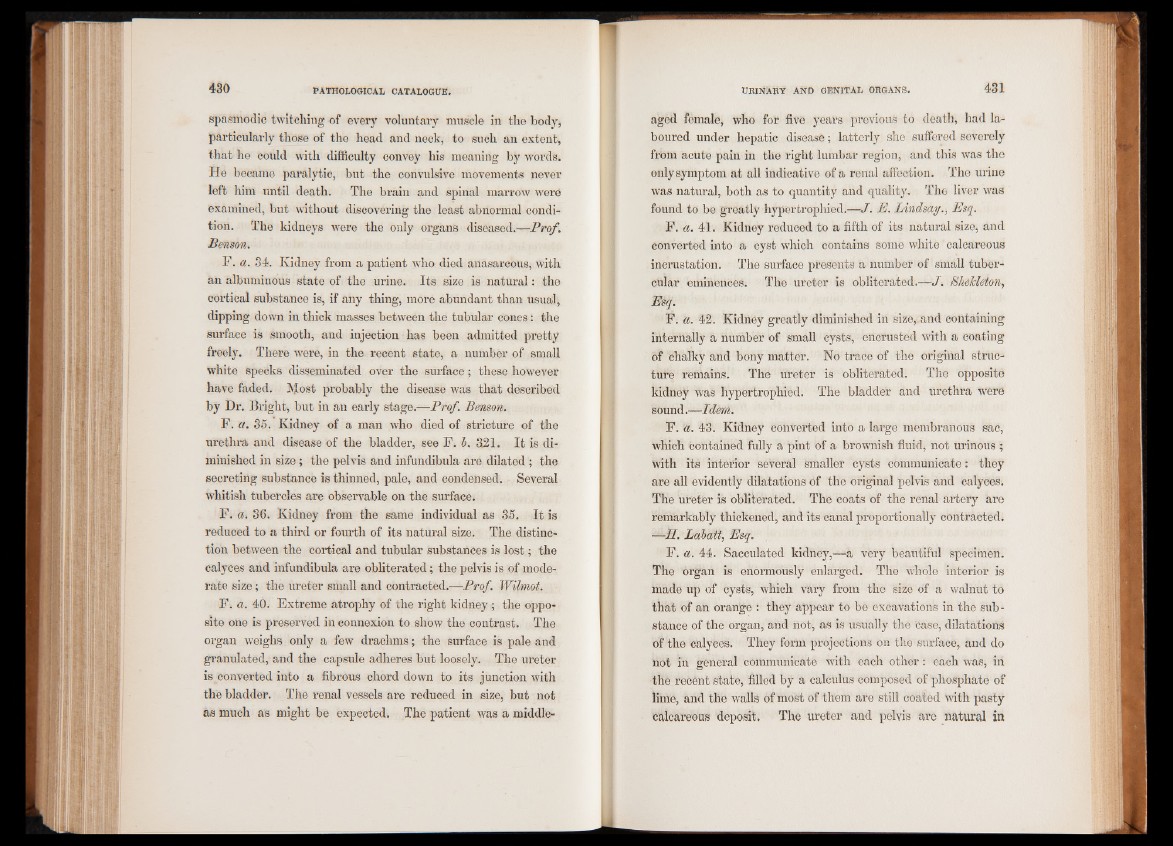
spasmodic twitching of every voluntary muscle in the body,
particularly those of the head and neck, to such an extent,
that he could with difficulty convey his meaning by words.
He became paralytic, but the convulsive movements never
left him until death. The brain and spinal marrow were
examined, but without discovering the least abnormal condition.
The kidneys were the only organs diseased.—Prof.
Benson.
F . a. 34. Kidney from a patient who died anasarcous, with
an albuminous state of the urine. Its size is natural: the
cortical substance is, if any thing, more abundant than usual,
dipping down in thick masses between the tubular cones: the
surface is smooth, and injection has been admitted pretty
freely. There were, in the recent state, a number of small
white specks disseminated over the surface; these however
have faded. Most probably the disease was that described
by Dr. Bright, but in an early stage.—Prof. Benson.
F. a. 35. Kidney of a man who died of stricture of the
urethra and disease of the bladder, see F. 1. 321. It is diminished
in size; the pelvis and infundibula are dilated ; the
secreting substance is thinned, pale, and condensed. Several
whitish tubercles are observable on the surface.
F. a. 36. Kidney from the same individual as 35. It is
reduced to a third or fourth of its natural size. The distinction
between the cortical and tubular substances is lost; the
calyces and infundibula are obliterated; the pelvis is of moderate
size; the ureter small and contracted.—Prof. Wilmot.
F. a. 40. Extreme atrophy of the right kidney; the opposite
one is preserved in connexion to show the contrast* The
organ weighs only a few drachms; the surface is pale and
granulated, and the capsule adheres but loosely. The ureter
is converted into a fibrous chord down to its junction with
the bladder. The renal vessels are reduced in size, but not
as much as might be expected. The patient was a middleaged
female, who for five years previous to death, had laboured
under hepatic disease; latterly she suffered severely
from acute pain in the right lumbar region, and this was the
only symptom at all indicative of a renal affection. The urine
was natural, both as to quantity and quality. The liver was
found to be greatly hypertrophied.—J. E. Lindsay., Esq.
F. a. 41. Kidney reduced to a fifth of its natural size, and
converted into a cyst which contains some white calcareous
incrustation. The surface presents a number of small tubercular
eminences. The ureter is obliterated.—J. Shekleton,
Esq.
F; a. 42. Kidney greatly diminished in size, and containing
internally a number of small cysts, encrusted with a coating
of chalky and bony matter. No trace of the original structure
remains. The ureter is obliterated. The opposite
kidney Was hypertrophied. The bladder and urethra were
sound.—Idem.
F. a. 43. Kidney converted into a large membranous sac,
which Contained fully a pint of a brownish fluid, not urinous ;
With its interior several smaller cysts communicate: they
are all evidently dilatations of the original pelvis and calyces.
The uret'er is obliterated. The coats of the renal artery are
remarkably thickened, and its canal proportionally contracted.
—II. Lalatt, Esq.
F. a. 44. Sacculated kidney,—a very beautiful specimen.
The organ is enormously enlarged. The whole interior is
made up of cysts, which vary from the size of a walnut to
that of an orange : they appear to be excavations in the substance
of the organ, and not, as is usually the Case, dilatations
of the calyces. They form projections on the surface, and do
not in general communicate with each other: each was, in
the recent state, filled by a calculus composed of phosphate of
lime, and the walls of most of them are still coated with pasty
calcareous deposit. The ureter and pelvis are natural in